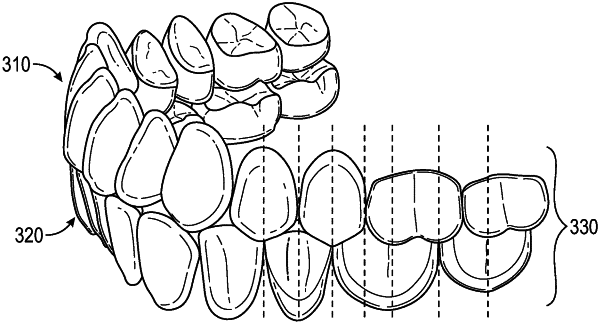| CPC A61C 13/0004 (2013.01) [A61C 9/0053 (2013.01); G16H 10/60 (2018.01)] | 12 Claims |

|
1. A computer implemented method for maintaining anatomical relationships between teeth while designing or modifying digital prosthetic upper and lower arches, the method comprising the following steps:
Contemporaneously adapting or modifying a prosthetic tooth structures by a computer software program to maintain proper anatomical relationships between prosthetic tooth structures in upper and/or lower prosthetic archforms in reaction to modification of the upper and/or lower prosthesis archforms by a user,
Contemporaneously adapting or modifying the occlusal and interproximal tooth surfaces of adjacent teeth to maintain proper anatomical relationships, from mesial/distal translation due to design or modification of an upper or lower arch forms by a user;
Contemporaneously adapting or modifying the occlusal and interproximal tooth surfaces of antagonist teeth to maintain proper anatomical relationships due to coronal/apical translation;
Contemporaneously adapting or modifying the occlusal and interproximal tooth surfaces of antagonist teeth to maintain proper anatomical relationships due to buccal/lingual translation;
Contemporaneously adapting or modifying the occlusal and interproximal tooth surfaces of antagonist and adjacent teeth to maintain proper anatomical relationships due to mesial/distal rotation/tilt;
Contemporaneously adapting or modifying the occlusal and interproximal tooth surfaces of antagonist and adjacent teeth to maintain proper anatomical relationships due to buccal/lingual rotation/tilt; and
Contemporaneously adapting or modifying the occlusal and interproximal tooth surfaces of antagonist and adjacent teeth to maintain proper anatomical relationships due to flare rotation, wherein the steps in the recited method have the effect of the computer software program contemporaneously maintaining anatomical relationships of prosthetic tooth structures in upper and/or lower prosthetic archforms in response to any changes made by the user to the design of a digital prosthesis.
|